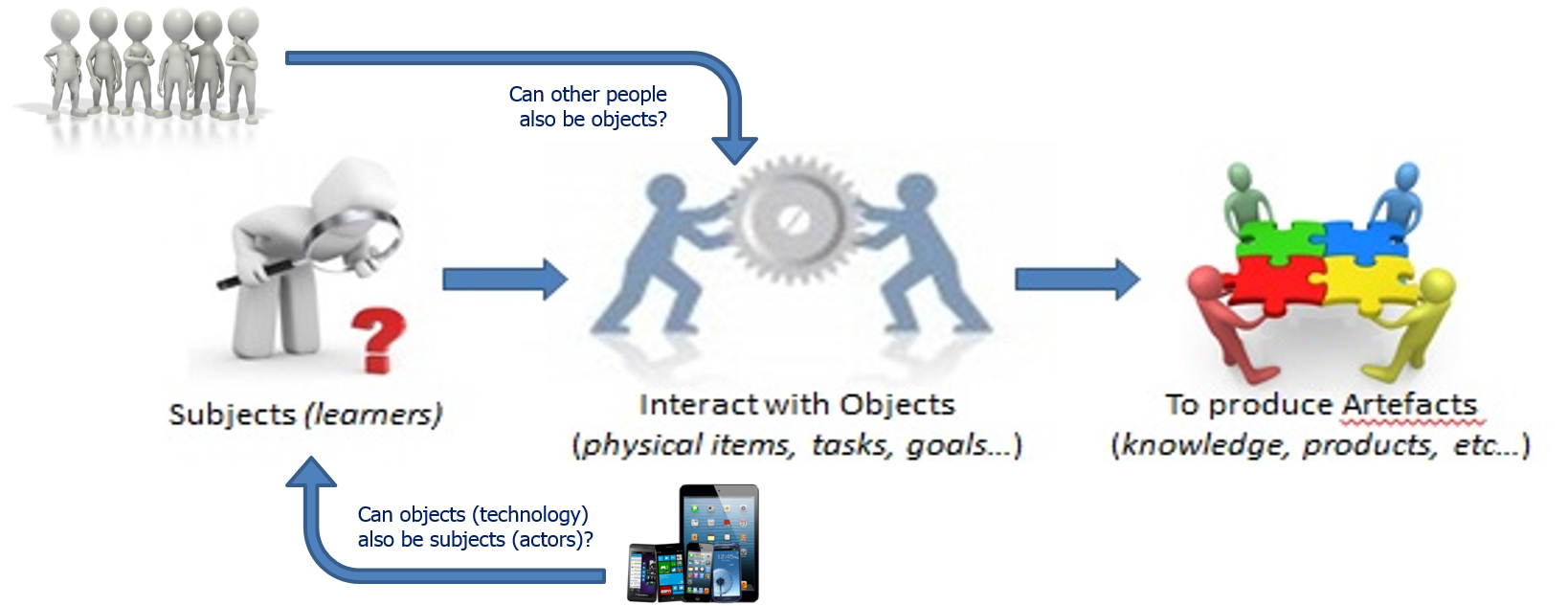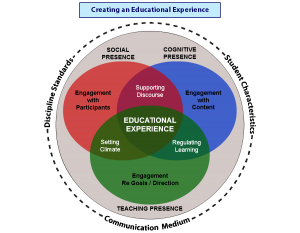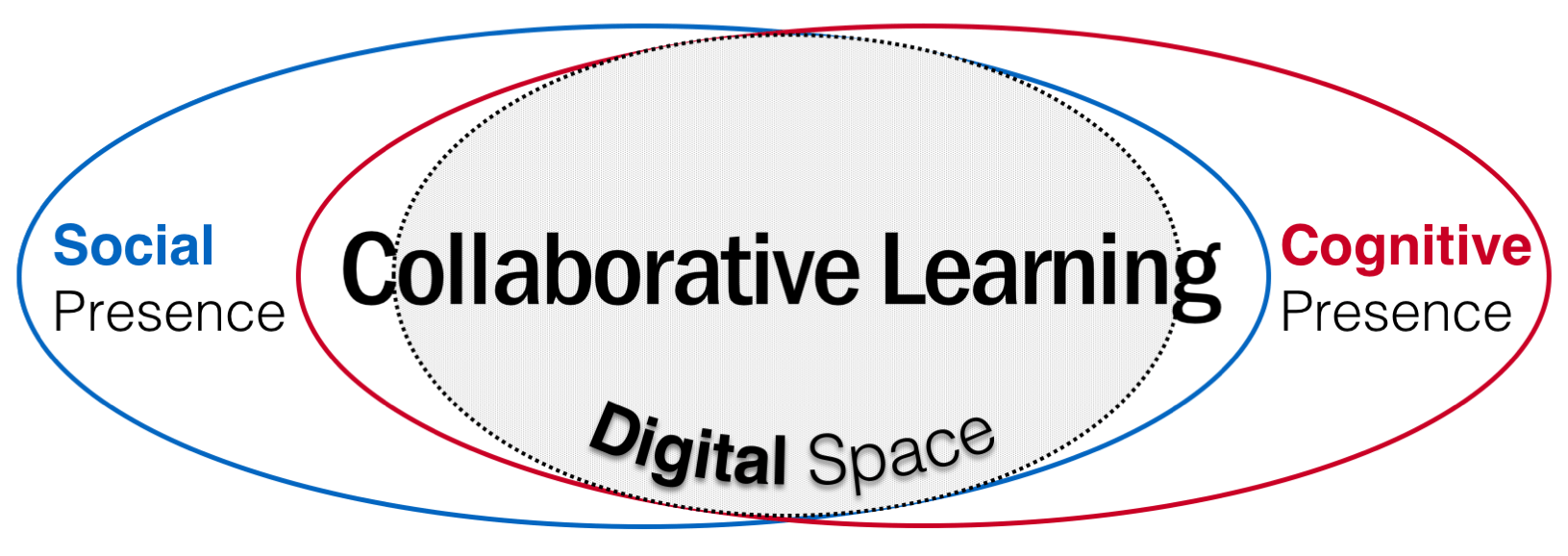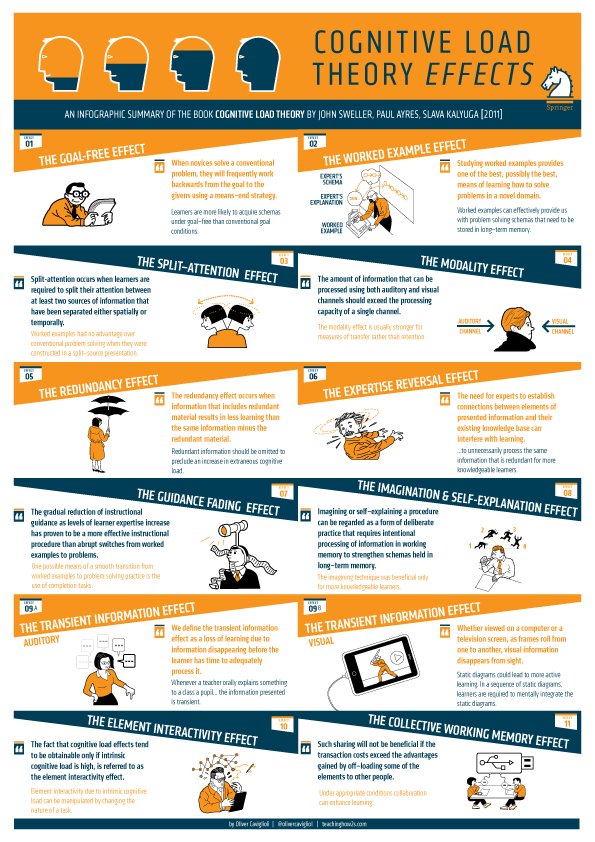7 Theories and Models of Online Learning
In this chapter, we change gears a little bit. Good instructional design, like good teaching, is grounded in and informed by learning theory. For some of you, much of this week will take you back to your education degree courses. However, I have tried to take it one step further. The chapter is divided into three parts. The first section examines traditional learning theory (behaviorism, cognitivism, constructivism, activity theory). Some of these theories you may already be familiar with. The second section looks at creating communities of learning, with a focus on transactional distance, Communities of Inquiry, social presence, and the Fully-Online Learning Community model. The third section looks at Cognitive Load Theory and how to manage cognitive load for our learners. Again, entire courses could be dedicated to each of these theories. The objective of this chapter is to review some of the key theories that have guided my work in instructional design for online teaching and learning.
Back to the Basics
Behaviorism
McLeod (2022) summarizes behaviorism, or behaviorist learning theory, as a view that all behaviors are “learned through interaction with the environment through a process called conditioning.” In this view, students respond to stimuli, and repeated exposure or practice leads to learning. The drawback is that behaviorism is “only concerned with observable stimulus-response behaviors,” which makes it a difficult theory to guide deeper learning, application of complex concepts, or the assessment of higher-order thinking skills.
BlueSofaMedia (2012a) offers a “light-hearted video” on how to apply behaviorism:
Cognitivism
Cognitivist learning theory treats the mind like an information processing machine – or a computer. According to OpenLearn Create (2017), it focuses on how information is “received, organized, stored and retrieved by the mind. OpenLearn Create (2017) lists five key principles and implications of cognitivism for teaching and learning:
- Learning is a process of organizing information into conceptualized models.
- Instructions should be organized, sequenced, and presented in a manner that
is understandable and meaningful to the learner. - Retention and recall is important to build schemas in the brain.
- Memory is supported by organizing learning material.
- Teachers must provide tools that help learners’ brain process information.
BlueSofoMedia (2013) offers a light-hearted overview of how to incorporate cognitivism into teaching and learning practice:
Constructivism
According to McLeod (2019), the constructivist learning theory states that people learn by constructing meaning out of their interactions with new information and experiences, and relating these to their existing experiences and understandings of the world. McLeod lists five key principles of constructivist learning:
- Knowledge is constructed rather than passively absorbed.
- Learning is an active process.
- All knowledge is socially constructed.
- All knowledge is personal.
- Learning exists in the mind.
BlueSofoMedia (2012b) offers a light-hearted look at what constructivism encompasses and how to leverage it in teaching and learning:
Social Constructivism and Activity Theory
Activity Theory tells us that when learning, we, as “subjects,” interact with “objects” (our environment, learning materials, tools, etc.), with a purpose in mind. As a result of that interaction, we create “artifacts” of our learning (new knowledge and skills, new physical artifacts to display what we have accomplished, new tools, etc.). Social Constructivism says that meaning is assigned to objects and that our motives and interactions are determined by social conventions — which both generate possibilities and create limitations to how we interact with each other and with objects. Thus, our learning activities are influenced by socially constructed meanings and rules.
How does this impact our decisions about technology integration? How can we leverage this knowledge to integrate technology to improve learning possibilities?

Robertson (2008) provides a good overview of Activity Theory
Tied closely to Activity Theory is the concept of the Zone of Proximal Development (ZPD). ZPD tells us that there is only so much an individual learner can accomplish without assistance at any given point. However, with appropriate scaffolding — including through collaboration with peers — we can increase the range of what the collective can accomplish together. This, in turn, results in an eventual increase in what the individual can accomplish on their own. The idea is to reduce the “red zone” of what a learner cannot or will not do without assistance.
How can we leverage technology to maximize the zone of proximal development for individuals and groups of learners?

Rodriguez (2014) provides a good introduction to the Zone of Proximal Development:
Connectivism
Connectivism (Siemens, 2005) is a learning theory in which knowledge exists outside of the learner, and the learner makes connections between information to build knowledge. The connections that learners make help them create their own learning network. Through this connected web, learners will be able to stay up to date with content as it changes. It is important for the learner to be able to identify credible resources. Siemens outlines the major ideas of connectivism as:
- Learning and knowledge rest in a diversity of opinions.
- Learning is a process of connecting specialized nodes or information sources.
- Learning may reside in non-human appliances.
- Capacity to know more is more critical than what is currently known
- Nurturing and maintaining connections is needed to facilitate continual learning.
- The ability to see connections between fields, ideas, and concepts is a core skill.
- Currency (accurate, up-to-date knowledge) is the intent of all connectivist learning activities.
- Decision-making is itself a learning process. Choosing what to learn and the meaning of incoming information is seen through the lens of a shifting reality. While there is a right answer now, it may be wrong tomorrow due to alterations in the information climate affecting the decision.
Jonesrebandt (2016) provides a brief overview of the Connectivist learning theory:
Building Learning Communities
One outcome that instructional designers often wish to achieve in the implementation of their learning materials is the creation of a “learning community,” where students feel a sense of cohesion and connectedness with their fellow learners. The concept of learning communities has been extensively studied and discussed in the educational literature. While it is an older resource, Wilson and Ryder (1996) provide a good primer on this concept.
Consider the following questions:
- What is a learning community?
- What role can a learning community play in facilitating learning?
- Do you agree that the creation of a learning community is fundamental to learning? Why or why not?
- Have you experienced being in a learning community yourself? If so, what was it like?
Transactional Distance Theory
Moore’s (1989, 1991) Transactional Distance Theory (TDT) has had a significant impact on how researchers and practitioners think about, and approach instructional design for distributed learning. TDT describes the physical and perceived “distances” between learners and their peers, learners and content, and learners and their instructors/coaches.

Simonson (2013) provides a good overview of Transactional Distance Theory.
An ideal blended or distributed learning scenario will use technology to help reduce those perceived distances as much as possible, even if physical distances cannot be controlled. Moore’s work pre-dates the World Wide Web, and modern distributed learning. But it shares connections with the Community of Inquiry model. Murphy and Rodriguez-Manzanares (2008) revisit the concept of transactional distance, and discuss how it applies to more recent developments in web-based teaching and training.
Office of Innovative Teaching and Technology (2018) provides some strategies for overcoming Transactional Distance:
Communities of Inquiry
Simply presenting content in an online teaching unit is not enough. Content alone may promote some degree of Cognitive Presence – or engagement with learning content. But, actually learning and applying that content can be significantly enhanced when it is combined with other forms of engagement in a learning experience. Garrison, Anderson and Archer’s (2000) landmark paper landed the Community of Inquiry (CoI) model at the forefront of program and instructional design thinking for blended and distributed learning over the past two decades. The Community of Inquiry Model (Athabasca University, 2016; Garrison, Anderson & Archer, 2000) describes the intersections of Social Presence, Teacher Presence, and Cognitive Presence, to establish a truly immersive learning environment.

The Community of Inquiry Model
All three of the critical “presences” depicted by the CoI model must be addressed and nurtured for everyone to get the most out of technology-mediated teaching and training.
Watch the following overview of the Community of Inquiry Model:
Additional Resources
 Athabasca University (n.d.) hosts a growing body of resources and the Community of Inquiry Alliance (it’s free to join!).
Athabasca University (n.d.) hosts a growing body of resources and the Community of Inquiry Alliance (it’s free to join!).
Increasing Social Presence in Communities of Inquiry
Well-selected, easy-to-digest content will help establish Cognitive Presence for your learners. You have already begun to establish Instructor Presence through the creation of your own Instructor Introduction video. You can further inject Instructor Presence by providing clear, concise guidelines and instructions in your Online Teaching Module, as well as by providing comprehensive, applicable formative and summative feedback to your learners. But what about creating Social Presence? What role does Social presence play?
Additional Resources
 If you’d like to delve deeper into Social Presence, take some time to review Gunawardena’s (1995) Social Presence Theory and Implications for Interaction and Collaborative Learning in Computer Conferences.
If you’d like to delve deeper into Social Presence, take some time to review Gunawardena’s (1995) Social Presence Theory and Implications for Interaction and Collaborative Learning in Computer Conferences.
One way to promote Social Presence in online teaching is through appropriately integrating Web 2.0 technologies – otherwise known as social software. The following video from the College of Fine Arts and the University of New South Wales (2011) explores how they have used common social tools, including Twitter, wikis, and blogging, for teaching and learning.
Do You Really Need All Three Presences?
The Community of Inquiry framework has become a benchmark for fostering optimum engagement in distributed learning scenarios. But do you really need high levels of all three presences (Social, Content, Teacher)? Some scenarios (maybe even the one you are working on for your ID Project) call for self-paced, individualized learning. What happens if an instructional design project does not allow for a high level of social presence?
Interaction Equivalency Theorem
Anderson (2003) posited that if any one presence is of sufficiently high quality, it could allow for the reduction — if not elimination — of one of the other presences. Review the resources to learn more about Anderson’s Interaction Equivalency Theorem, and its possible implications for your instructional design projects.
Additional Resources
 If you would like to learn more about Interaction Equivalency Theorem, check out the Interaction Equivalency (EQuiv) Website
If you would like to learn more about Interaction Equivalency Theorem, check out the Interaction Equivalency (EQuiv) Website
The Fully-Online Learning Community Model
While the Community of Inquiry (CoI) model has formed the cornerstone of much of the research and practice in online and distributed learning since the turn of the century (Kineshanko, 2016), other models have arisen that have attempted to expand on its principles and provide more insight into relationships in modern digital learning communities. Researchers from Ontario Tech University have proposed a variation of the CoI model and Transactional Distance Theory called the Fully Online Learning Community (FOLC) model (Blayone et al., 2017; EILAB, 2022; Webb et al., 2019). The FOLC model highlights the importance of social and cognitive presence and also promotes the critical role of the co-creation of digital collaborative learning spaces by instructors and students.

Reducing Cognitive Load
Why Should We Reduce Cognitive Load for Our Learners?
Pappas (2014) provides a good brief overview of what cognitive load theory is, and how cognitive load affects our instructional design decisions when using technology for teaching and training. When learners interact with technology, they receive new information via their working (short-term) memory. Our aim when designing instruction with technology is to help the learner transfer that new information from short-term memory into their long-term memory. The key thing that cognitive load theory tells us is that if we put too much strain on our working (short-term) memory, then we lost the ability to transfer new information into long-term memory.
Effects of Cognitive Load on Online Learners
Cavigliolo (2017) shared an infographic that summarizes the potential effects of cognitive load theory on online learners:

Reducing Cognitive Load
Pappas (2014) provides tips for helping control the cognitive load burden for online learners. Guyan (2013) describes three types of cognitive load that impact learners’ ability to make this information transfer – the complexity of the information we are trying to learn (intrinsic load), the background noise (non-essential information, such as graphics, animations, etc… or even the need to learn how to use a platform to access the learning material) we encounter that do not add anything to what we are trying to learn (extrinsic load), and elements that make it easier for learners to receive and interpret new information (germane load). The capacity of our working memory to receive, interpret, and transfer new information to long-term memory is the total of the intrinsic, extrinsic, and germane cognitive loads we experience. To increase learner engagement and success, we need to balance these loads. When selecting technologies to integrate into teaching and training, we should keep the intrinsic cognitive load at a level appropriate to our learners’ needs and learning objectives. We should also strive to minimize extrinsic load and capitalize on germane elements that can help learners more efficiently receive and interpret new information.
Further Reading

- Read Pappas (2014)’s Cognitive Load Theory and Instructional Design
- Read Guyan (2013)’s 5 Ways to Reduce Cognitive Load in eLearning
References
2turtlerun (2009, November 28). Social Presence: An Introduction. https://youtu.be/lJVLHAA90jc
Anderson, T. (2003). Getting the Mix Right Again: An updated and theoretical rationale for interaction. International Review of Research in Open and Distributed Learning, 4(2). https://doi.org/10.1016/S1096-7516(00)00016-6
Athabasca University (n.d.). Community of Inquiry. https://coi.athabascau.ca/
Blayone, T., vanOostveen, R., Barber, W., DiGiuseppe, M., & Childs, E. (2017). Democratizing digital learning: Theorizing the Fully Online Learning Community model. International Journal of Educational Technology in Higher Education, 14(1), 13. https://doi.org/10.1186/s41239-017-0051-4
BlueSofaMedia (2012, December 31 a). Use a Learning Theory: Behaviorism. https://youtu.be/KYDYzR-ZWRQ
BlueSofaMedia (2012, December 31 b). Use a Learning Theory: Constructivism. https://youtu.be/Xa59prZC5gA
BluesofaMedia (2013, July 5). Use a Learning Theory: Cognitivism. https://youtu.be/gugvpoU2Ewo
Borup, Jered. (2014, June 20). Community of Inquiry. https://youtu.be/273WuFa6Z04
Caviglioli, O. (2017). Cognitive Load Theory Effects. [Infographic].
COFAonlineUNSW. (2011, February 16). Teaching with web 2.0 technologies: Twitter, wikis & blogs – Case study. https://youtu.be/V5tSSgBJq2s
EILAB (2022). Fully Online Learning Community (FOLC) Model. https://eilab.ca/fully-online-learning-community/
Garrison, D. R., Anderson, T., & Archer, W. (2000). Critical inquiry in a text-based environment: Computer conferencing in higher education model. The Internet and Higher Education, 2(2-3), 87-105. https://auspace.athabascau.ca/handle/2149/739
Gunawardena, C. (1995). Social Presence Theory and Implications for Interaction and Collaborative Learning in Computer Conferences. International Journal of Educational Telecommunications, 1(2–3), 147–166. https://www.learntechlib.org/p/15156
Guyan, M. (2013, November 1). 5 ways to reduce cognitive load in eLearning. [Web log post]. eLearning Industry. https://elearningindustry.com/5-ways-to-reduce-cognitive-load-in-elearning
The Interaction Equivalency (EQuiv) Website (n.d.). http://equivalencytheorem.info/
Jonesrebandt, E. (2013, October 22). Connectivism. https://youtu.be/cFCYjm6nf40
Kineshanko, M. (2016). A thematic synthesis of Community of Inquiry research 2000 to 2014. (Doctoral dissertation, Athabasca University). http://hdl.handle.net/10791/190
McLeod, S. (2017). Constructivism as a theory for teaching and learning. SimplyPsychology. https://www.simplypsychology.org/constructivism.html
McLeod, S. (2022, August 18). Behaviorist Approach. SimplyPsychology. https://www.simplypsychology.org/behaviorism.html
Moore, M. (1989). Editorial: Three types of interaction. The American Journal of Distance Education, 3(2), 1-7. http://dx.doi.org/10.1080/08923648909526659
Moore, M. (1991). Editorial: Distance education theory. The American Journal of Distance Education, 5(3), 1-6. http://dx.doi.org/10.1080/08923649109526758
Murphy, E., and Rodriguez-Manzanares, M. (2008). Revisiting transactional distance theory in a context of web-based high-school distance education. International Journal of E-Learning and Distance Education, 22(2), 1-14. http://www.ijede.ca/index.php/jde/article/view/38/550
Office of Innovative Teaching and Technology (2018, February 14). Overcoming Transactional Distance. https://youtu.be/gjFD3enZaRc
OpenLearn Create (2017). Cognitivism. https://www.open.edu/openlearncreate/mod/page/view.php?id=147079
Pappas. C. (2014, February 5). Cognitive load theory and instructional design. [Web log post]. eLearning Industry. https://elearningindustry.com/cognitive-load-theory-and-instructional-design
Robertson, I. (2008, August 7). An Introduction to Activity Theory. https://youtu.be/4oG0ZvkhzCY
Rodriguez, M. (2014, March 5). Zone of Proximal Development. [YouTube video]. https://youtu.be/Du6vqSOj7UU
Siemens, G. (2005). Connectivism: A Learning Theory for the Digital Age. International Journal of Instructional Technology and Distance Learning, 2(1). http://www.itdl.org/Journal/Jan_05/article01.htm
Simonson, M. (2013, June 6). ITDE Applications – Transactional Distance Theory. https://youtu.be/Qph1gbQhK_8
Webb, S., van Oostveen, R., Barber, W., Percival, J. & Childs, E. (2019). Co-creation of the digital space: Examining the use of web-based tools in Fully Online Learning Community (FOLC) environments. In J. Theo Bastiaens (Ed.), Proceedings of EdMedia + Innovate Learning (pp. 1237-1242). Amsterdam, Netherlands: Association for the Advancement of Computing in Education (AACE). https://www.learntechlib.org/primary/p/210135/
Wilson, B., & Ryder, M. (1996). Dynamic Learning Communities: An Alternative to Designed Instructional Systems. Proceedings of Selected Research and Development Presentations at the 1996 National Convention of the Association for Educational Communications and Technology (18th, Indianapolis, IN, 1996). https://files.eric.ed.gov/fulltext/ED397847.pdf
